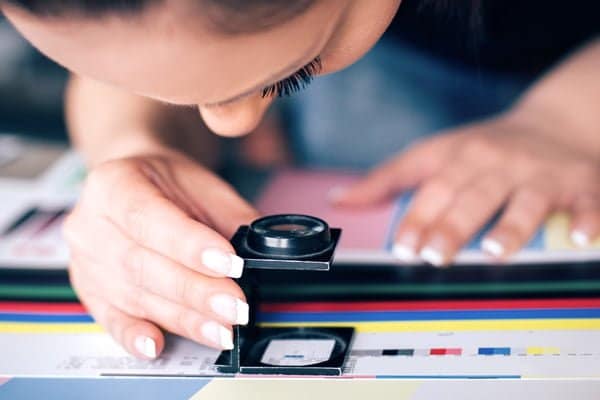Proofing and Checking
What are proofs?
A proof is a recreation of how your design will look when it’s printed. Proofs are prepared by printing companies to check everything is in order before going to print; the proof is then sent to the client (along with any recommendations for changes) to make sure they’re 100% happy with the design as it will be printed. It’s basically the same as proofreading a novel before publishing it.
Proofs are important for catching any possible mistakes in the design – including any layout issues, spelling mistakes, typography errors and colour problems – so that they can be fixed before going to print. There’s nothing more frustrating than spotting a tiny mistake in your design after you’ve just received ten thousand printed copies of it.

Artwork Checking
If you are unsure about submitting up your artwork you can read our guide to accepted file formats here. If you have still any doubts you can always submit your PDF or a sample page from a larger document you are planning for us to have a quick review in our studio. We have all the adobe programmes plus we use Pitstop pro a handy PDF plug-in for checking colour profiles and breakdowns, image resolution and font embedding.

PDF colour check
PDF Proofs
A PDF proof is sometimes referred to as a soft proof, a digital proof or a RIPD proof. This is essentially a pdf emailed to the customer for checking against your original submitted artwork.
The PDF is imported into our RIP (Raster Image Processor) this converts the file into a TIFF that is what we print from. The Proof PDF will be ‘data intact’ as in what you viewing on screen is what will print.
This applies mainly to the actual content, that is the fonts, images and any shadows or boxes and graphic elements, in order to keep file sizes down so that they are OK to email and thus improve print turnaround times a PDF proof will typically be lower resolution, so while not affecting content, colours will not be displayed with 100% accuracy.
Hard copy proof
Unlike a digital PDF proof, a hard copy proof, sometimes known as a paper copy or an Epson proof (as we use an Epson P700 printer) is supplied as a printed paper document. Hard copies are produced using a colour-calibrated digital inkjet printer and are typically printed on glossy paper (which may or may not match the substrate material of the product you’re printing).
A hard copy proof is not essential and we do less here as digital printing is constantly improving in matching the accuracy of a litho press, however a hard copy will give a very accurate representation of what a litho press will produce as they are calibrated to match our press and for every litho run our minders will match to a hard copy proof .
For expensive jobs where colour matching /checking is essential and the job is printed on a litho press then we will produce and mail out a hard copy proof (charges may apply) for you to check.

Hard copy proof being printed
Wet Proof
A wet copy proof is printed on a lithographic press, using the same material and the same inks as the final printed product. This means the wet proof will look exactly the same as the finished item.
Wet copy proofs are costly to produce, so they’re not really an economical choice for most printed marketing materials (especially as they often have a short shelf life and they’re typically produced in smaller quantities).
However, if you’re looking to print a high-profile item in large quantities, and colour accuracy is vital for the product in question, it often pays to get a wet copy proof before going to print.
If you are still unsure about proofing and checking or have any questions then call us on 023 8087 8037 or email us.